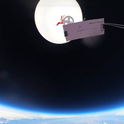This article is sponsored by Ricardo Plc
The UK government has laid out an ambitious 10-point plan for a Green Industrial Revolution. Before we look ahead to the transport elements of the plan, it’s useful to look back to the first Industrial Revolution which was successful but took centuries to develop. Rapid urbanisation, plus the expansion of agriculture, industry and trade—which fostered the UK’s high wage, cheap energy economy—provided the perfect environment for transformational technological innovations. These technologies eventually globalised, but at their outset were barely profitable and confined to the UK for many years, as they addressed British economic conditions. As the efficiency of the innovations improved so the Industrial Revolution globalised.
Are there useful parallels that we can draw? Today we are removing our dependency on coal (by 2025) and shifting to gas and renewable sources such as wind power. The decarbonisation of the energy supply sector is the largest contributor to the decrease in CO2 emissions in the UK. BEIS estimates the “levelised cost of electricity” (LCOE) for 2025 to be £46/MWh and £57/MWh for onshore and offshore wind respectively and £44/MWh for large solar deployments compared to £85/MWh for a gas power station; so renewables will offer us a cheaper supply of “clean” electricity. This will offer a lever to help decarbonise many parts of the economy.
Green innovations will need help getting off the ground and innovation funding will help the development and early adoption of technologies which may not be immediately economically viable. Private investment helped drive the first Industrial Revolution and with the planned green financial measures (including the Sovereign Green Bonds) aiming to incentivise investment and develop voluntary carbon markets, we can design and accelerate the conditions for change today far more quickly than two centuries ago.
Climate change requires a rapid response which is co-ordinated across the economy, but the problem is complex. The EU’s Renewable Energy Directive (2009) is a good example of how well-meaning regulation can have a negative impact—in this case the promotion of food-based biofuels for transport did not take account of the indirect land use change (ILUC) emissions in the greenhouse gas (GHG) accounting, leading to a cap being put on production in 2015. A systems-led approach is required to ensure that we make the right decisions, avoiding “burden shifting” of emissions and making the optimal decisions for limited energy resources.
Ricardo has always led the way in employing systems-led thinking in many customer programmes from the engineering of battery packs within electric vehicles to the development of a net zero strategy for the UK water industry. Life cycle thinking helps to reveal possible trade-offs between environmental impacts in different phases of a product. Ricardo has over 25 years’ experience deploying Life Cycle Assessment including HS2 rolling stock, automotive vehicles and industrial products.
As the largest contributor to UK GHG emissions, transport (road, rail, marine, aviation) is a critical sector to address. If we consider point four (Accelerating the Shift to Zero Emissions Vehicles), measures already announced relating to the banning of petrol and diesel cars and vans will assist in reducing emissions. Transport electrification is already central to Ricardo, and we are actively assisting customers with the development of advanced battery electric and hybrid vehicles. Much of the supply chain for electric vehicles is overseas and funding will assist the development of battery “gigafactories” within the UK. This will become an essential requirement to ensure the tariff-free trade export of electrified vehicles to the EU. Ricardo is also supporting the development of the UK supply chain for Power Electronics, Machines and Drives (PEMD) leading a consortium working on an innovative electric motor for transport.
The number of cars over 13 years old has tripled in the last 25 years and this represents a significant contributor of CO2 emissions for many years to come. The use of biofuels (derived from woody biomass, or agricultural residues/waste) and e-fuels would provide a glide path until the petrol and diesel vehicle parc is retired. This existing UK vehicle parc (over 40m vehicles) is not addressed by the current plan. In 2019, the number of new cars purchased was 2.3m so it will take many years to replace this parc with zero emission vehicles. Ricardo’s vast experience in engine technology can help support companies to develop and test new bio- and e-fuels.
Clearly, the main focus of point four relates to cars, where the bulk of road transport emissions are created. However, with the consultation on the phasing out of new diesel heavy goods vehicles (HGVs) planned, it is important to realise that zero emissions solutions are more challenging than for cars. Battery electrification may not be economical, or practical, for all freight applications and hydrogen may offer a more suitable zero tailpipe emission solution. When we consider life cycle assessment approach to hydrogen usage within transport, the CO2 emissions associated with hydrogen generation is taken into account.
Today, almost all hydrogen is generated from fossil fuels releasing vast quantities of CO2 in the process. If we are to make hydrogen a part of our Green Industrial Revolution, we need to address the production process. Point two (Driving the Growth of Low Carbon Hydrogen) aims to develop 5GW of low carbon hydrogen by 2030. This will be achieved using Carbon Capture, Usage and Storage (CCUS) on existing fossil fuel processes (so called “blue” hydrogen) and electrolysis, powered by renewable electricity, to produce “green” hydrogen. One of the fundamental challenges is with limited low carbon hydrogen, determining where hydrogen should be used. There are many competing applications and insufficient infrastructure for distribution.
Point five (Green Public Transport, Cycling and Walking) includes investment for a National Bus Strategy. Again, electrification is key with funding for two all-electric bus towns. The reference to “British built zero emission buses” perhaps leaves the door open for hydrogen-fuelled buses too. Ricardo is expanding geo-fencing technology currently in operation in the UK’s first zero emissions geo-fenced bus fleet in Brighton and Hove, investigating the use of hydrogen fuel cells to convert existing diesel bus fleets, and has developed artificial intelligence software to model the suitability and cost of bus route electrification using route and bus schedule data to analyse and optimise battery and charging requirement and costs.
Further electrification of the rail network and extensions to smaller locations will help increase rail routes and further decarbonise the network. Rail is ideally suited to direct use of renewable energy with potential for direct connection of renewable systems to the electrified lines. Combined with line-side energy storage systems these can reduce losses from transmission of energy. Ricardo has already partnered on the development of a solar-powered railway.
One of the challenges with the 10-point plan is that transport is not considered holistically yet. The promise of a Transport Decarbonisation Plan may remedy this. For example, moving more freight by rail would reduce GHG emissions by a factor of four. With a multi-modal policy for both freight and personal/passenger transport, underpinned by incentivisation schemes from government, a viable business case to decarbonise further portions of the network and reduce GHGs would be provided. Road User Charging (RUC) based on environmental impact could help that shift.
With a systems-led approach we can address some of the distribution challenges of hydrogen. Aviation and marine are addressed by point six (Jet Zero and Green Ships). Hydrogen plays a role in helping to drive net zero aviation and clean maritime technology. Integration of transport energy needs can help support the transition of the transport sector to hydrogen, through the utilisation of combined rail depots, terminals and freight distribution centres on key corridors developing multi-modal hydrogen hubs which can service road, rail freight, aviation and marine. This would further support the shift to the most effective transport mode for greatest GHG benefit, forming spoke and hub systems where long distance freight would effectively be transported by rail to local distribution centres, which enable captive delivery road fleets powered by hydrogen or using electric batteries.
The first Industrial Revolution took several centuries to come to fruition. We have far less time to address climate change, so it is essential that any plan will accelerate our Green Industrial Revolution before the UK’s net zero deadline of 2050. The 10-point plan is a much-needed boost, but to really capitalise on the investment and ensure the greatest contribution to reducing our GHG footprint we need to look at the overall system holistically. With hydrogen offering so many options both in transport and industry, scaling the right application will be critical. We do not currently have an untapped supply of low carbon hydrogen and for many applications, electrification will provide the most efficient route. Ricardo’s breadth of expertise plays well into supporting the plan and we are extremely encouraged to see the investment from the UK government.
This article features in Prospect’s new “Green Recovery” report, published in partnership with SNC Lavalin, Atkins, Ricardo and the Aerospace Technology Institute. Read the full report PDF here.












